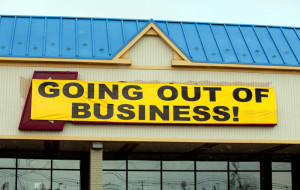Last week we discussed the tsunami of Baby Boomer retirement, and how we will reach a peak of nearly 500 unsold businesses a day within the next 5 years. The statistics are immutable. The birthrates of the last century are fixed in stone. (If you haven’t read my e-book Beating the Boomer Bust you can get it for free here. Use the download code “Woodstock”.)
Once you understand the inevitability of competing to sell your business in a buyer’s market, you have five choices. The first is to simply ignore it and hope for the best. For any owner who holds most of his or her net worth in the company, that’s not a great option.
The second is to watch, and wait for an opening. That requires following small business sales for favorable trends, and a flexible retirement plan that can take advantage of market conditions or an unexpected opportunity.
The third is planned liquidation. If you can achieve your financial goals by running the business a while longer, and you choose not to invest in building a company that runs without you, this is a viable strategy, albeit without the satisfaction of a large final payday.
The fourth is to build a business suitable for sale in a highly competitive environment. Such a company must have strong systems, dependable revenues, accomplished management (not including you), and profitability greater than most other companies a buyer might consider, whether those are in your industry or not.
 The fifth strategy is to build your own internal exit plan, and execute it without many of the unknowns involved when taking your business to the market. It requires choosing an insider (family or employee) who understands the business, and is happy to have the opportunity to own it. Of course, that person should also have the ability to run it successfully, or at least the potential to learn those skills.
The fifth strategy is to build your own internal exit plan, and execute it without many of the unknowns involved when taking your business to the market. It requires choosing an insider (family or employee) who understands the business, and is happy to have the opportunity to own it. Of course, that person should also have the ability to run it successfully, or at least the potential to learn those skills.
But wait. Didn’t I just write last week that selling the company to employees for a note was a terrible exit plan? I did, and it is. Selling the company to insiders doesn’t require that you bet your retirement on their continued success. With time and careful planning, it can be done in a way that minimizes or eliminates your risk.
First, any owner has to accept the fact that the company’s cash flow is the only means of payment for a purchase. Whether a buyer gives a note to you, borrows the price from a third-party lender, or invests cash with the expectation of a return on investment, the profits of the company are the source of repayment.
Selling to an insider is a process where you take a note from the buyer before you leave, while you are still in control of the business. The buyer’s right to purchase is predicated on improving performance. You surrender some immediate income in return for incentive triggers that make your total sale price equal to or higher than what you would currently realize.
Once your internal buyer accumulates sufficient equity to qualify, he obtains a loan for the balance of your ownership. You receive 80% or more of your target price on the day you retire, and walk away with minimum ongoing liability. (I say 80% because most financial institutions like to see some incentive for the former owner to watch and advise for a few years. It can be up to 100%, depending on the lender and the company.)
With the right plan and the right people, the business transfers at a fair price with minimal cost and lower risk. The buyer(s) (whether one person or a management team) are incented to keep growing the business to qualify for ownership. While they are doing that, they are also assuming the management duties from you as a prerequisite for ownership.
Most important, you maintain control of the business until you are paid. For most owners, that is the most influential argument of all.
This is a column about the general issues of business ownership. I discuss exiting regularly because it is an important issue, but it isn’t the only aspect of ownership we discuss here. To receive my biweekly newsletter on exit strategies and issues, please subscribe here.




